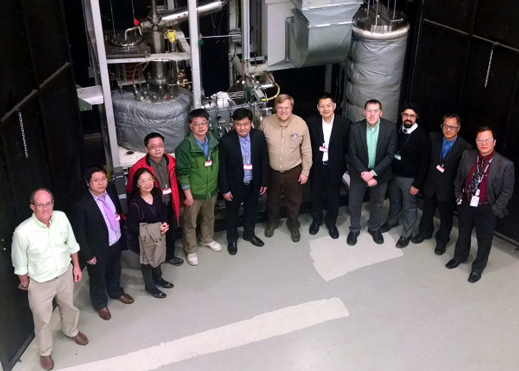China, in partnership with the U.S. Department of Energy, says it will deploy advanced nuclear reactors commercially by 2030. By Richard Martin on October 16, 2015 Why It Matters The development of molten-salt reactors could produce an essentially limitless source of safe, zero-carbon energy. 
Chinese and American scientists meet at Oak Ridge National Laboratory, scene of the historic molten-salt reactor experiment in the 1960s, to mark their collaboration on next-generation nuclear power. A group of nuclear scientists and entrepreneurs gathered this week at Oak Ridge National Laboratory, in Tennessee, to observe the 50th anniversary of the molten-salt reactor experiment—a program carried out at Oak Ridge in the 1960s to build a novel nuclear reactor. Molten-salt reactors use liquid, rather than solid fuel rods, as the fuel to produce the nuclear reactions that heat water to make steam and, in turn, electricity. They have several advantages over conventional light-water reactors in terms of safety, anti-proliferation, and economics, and are enjoying a renaissance as the world searches for sources of low-cost, low-carbon energy. The 50th anniversary workshop, which included presentations from reactor developers including TerraPower, Flibe Energy, Moltex Energy, and Terrestrial Energy, as well as the large utility Southern Power, marked the largest and most significant gathering to date of the people working to bring this innovative yet decades-old technology to commercialization. Among the presenters was Xu Hongjie, the director of the molten-salt reactor program at the Shanghai Institute of Applied Physics. Under the auspices of the Chinese Academy of Sciences, SINAP is collaborating with Oak Ridge to advance research on both salt-cooled reactors (which use molten salts to transfer heat and to cool the reactor) and salt-fueled reactors (in which the fuel, where the energy-producing nuclear reactions occur, is dissolved within the salt coolant). Signed in December 2011, the Shanghai-Oak Ridge effort has been the subject of controversy and speculation among the nuclear power community, particularly those promoting advanced technologies such as molten-salt reactors and the use of thorium, an alternative nuclear fuel that is cleaner, safer, and more abundant than uranium. At Oak Ridge this week, Xu outlined a roadmap that shows that China is further along than any other advanced reactor R&D program in the world. China, which still gets nearly three-quarters of its electricity from burning coal, is racing to develop low-carbon energy sources, including both conventional nuclear plants and advanced systems such as molten-salt reactors. The largest emitter of greenhouse gases in the world, China aims to more than double its nuclear capacity by 2020, according to the World Nuclear Association. Xu detailed a multi-stage plan to build demonstration reactors in the next five years and deploy them commercially beginning around 2030. The institute plans to build a 10-megawatt prototype reactor, using solid fuel, by 2020, along with a two-megawatt liquid-fuel machine that will demonstrate the thorium-uranium fuel cycle. (Thorium, which is not fissile, is converted inside a reactor into a fissile isotope of uranium that produces energy and sustains the nuclear reaction.) In all, there are 700 nuclear engineers working on the molten-salt reactor at SINAP, Xu said, a number that dwarfs other advanced-reactor research programs around the world. The team has a preliminary design for a 10-megawatt thorium-based molten-salt reactor, and has mastered some of the technical challenges involved in building and running such reactors, such as the preparation of high-purity molten salts and the control of tritium, a dangerous isotope of hydrogen that can be used in the making of nuclear weapons. Limiting the production of tritium is a key research goal for the development of molten-salt reactors. While most of the audience at Oak Ridge was familiar with the outlines of the Chinese program, the level of sophistication and the progress to date were startling to many listeners. “It’s very surprising how far they’ve come in four years,” said John Kutsch, the vice president for business development at Terrestrial Energy, which is developing its own version of a molten-salt reactor. “That shows you what throwing hundreds of researchers at a project will do to speed progress.” The Chinese program alarms some American researchers, who view China as a rival in the nuclear arena and are opposed to the sharing of technology that was originally developed in the United States. China is seeking not only to build reactors to supply domestic power but also to become a major supplier of nuclear technology to the world market. When the U.S.-China agreement was first announced, some commentators described the collaboration as a dangerous, even treacherous, form of technology transfer. Viewed from a broader perspective, the development of safe, economical nuclear power technology that can be commercialized and deployed rapidly would be a huge achievement in the struggle to limit global climate change, regardless of which country gets there first. Faced with a long path to funding and licensing their technology in the United States, many developers of next-generation nuclear reactors have said they will likely test their machines in other countries, including China. Under the collaboration agreement, says David Holcomb, the principal investigator from Oak Ridge on the program, “both institutions are seeking to more rapidly advance salt-cooled reactors. As such, the coӧperative work is jointly approved by both governments.” Like scientists everywhere, Xu is also faced with securing funding for the next phases of the program. SINAP’s molten-salt reactor research is funded through 2017, he says; beyond that the institute is seeking new funding from the central government, the Shanghai government, and the private sector. SINAP also recently signed an agreement with Fangda Group, a major Chinese conglomerate that produces carbon products, iron and steel, and chemicals, to help develop molten-salt coolants for the reactors. “I’m very confident” that SINAP will be able to carry its molten-salt reactor program to commercialization, Xu says. “Because, you see, in general the Chinese government intends to support the development of future technologies for nuclear energy. And the China market is very big for nuclear energy technologies.” http://www.technologyreview.com/news/542526/china-details-next-gen-nuclear-reactor-program/ |



























